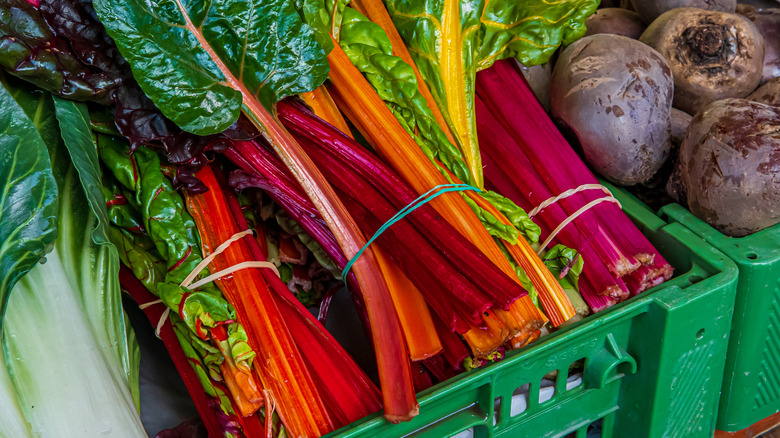For Maximum Nutrition, Save Your Swiss Chard Stems
One of the surprising things new cooks realize is how much fruit and vegetables are peeled away, trimmed off, or discarded. Some foods have an extra life before being tossed into the compost bin. For example, don't throw out leftover corn cobs, because they can be simmered into corn broth. And, most cooks know you don't need to throw out broccoli stalks because they can be peeled and are just as tasty as the florets.
For the most part, however, Swiss chard stems haven't made the leap from the compost bin back onto our plates. According to Healthline, Swiss chard is a relative of spinach and beets, and one of the healthiest vegetables we can eat. Leafy greens, like Swiss chard, are linked to reducing the risk of obesity, heart disease, high blood pressure, and even mental decline.
Swiss chard stems share the same nutrients, earthy flavors, and a pleasant crunch. No matter the color — pink, orange, red, white, yellow, or green — the stems are all packed with minerals and vitamins. And, according to America's Test Kitchen, another reason to appreciate Swiss chard is that it's such a hearty vegetable; it really has no season, like tomatoes or melon. Swiss chard is a year-round option for cooks.
Swiss chard stems are tasty and good for you
Aside from being tasty, easy to find, and incredibly healthy, Swiss chard is versatile. Wisconsin Horticulture points out that Swiss chard doesn't have to be cooked. So, adding Swiss chard leaves and stems to a salad is perfect. If you're leafy-vegetable averse — add a handful of Swiss chard to your smoothie.
If raw Swiss chard isn't for you, cook it. As America's Test Kitchen points out, the stems and leaves don't cook at the same rate. That's why so many people throw the stems out. The leaves wilt and become tender within a few minutes. The stems need more time to become tender but maintain their intensity and crisp texture. To get those different cooking times to coincide, they recommend pulling the leaves off of the stem, then chop the stems. The final piece to this puzzle is giving the stems a head start in the pot or pan. For example, you can make sautéed chard with garlic by sautéing the stems before adding the leaves.
Great ways to eat your swiss chard stems
Swiss chard, stems and all, plays well with so many foods and cuisines. So, there are limitless ways to add it to dishes you enjoy, like a Swiss chard and shiitake mushroom risotto. Or, making Swiss chard the star in some Swiss chard tacos.
There are creative ways that allow the stems to stand alone. You can grills chard stems and add them to any dish. In fact, grilling the stems intensifies the chard's flavor which goes really well with the char from the grill. Adding another strong flavor in the form of garlic oil ties everything together for a truly unique way to eat your greens.
Canadian Living suggests pickling the chard stems. These pickles are great for adding to salads or grain bowls. They'd be great in just about anything. Toss some into those Swiss chard tacos for a double dose of a superfood.


